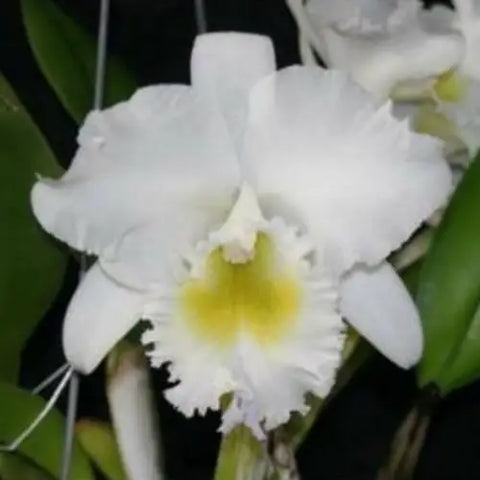
B. Yaki (cucullata x nodosa) – 2.5" Pot
B. Yaki (cucullata x nodosa) – 2.5" Pot
Fragrant, Star-Shaped Brassavola Hybrid with Lavender Blush
Brassavola Yaki is a fragrant primary hybrid created by crossing Brassavola cucullata with Brassavola nodosa. This hybrid combines the best features of both parents: long, narrow foliage, dramatic star-shaped flowers, and a bold citrus-like fragrance that intensifies at night.
These seedlings are grown from the same cross and may bloom with variation—some showing creamy whites or soft greens, others displaying pink blushes or light spotting. Flowers average about 4.5 inches wide, with a frilled lip inherited from B. nodosa, making each bloom both elegant and expressive.
Each plant is blooming size in a 2.5" pot and primarily flowers in summer, though spring and fall blooming is also possible with good conditions.
A beautiful hybrid. Colors can have varying degrees of lavender and spotting. These are seedlings. Flowers shown are examples from this same cross.
Why Growers Love B. Yaki
Growers love Brassavola Yaki for its elegant floral form, sweet fragrance, and forgiving nature. The blooms are showy yet delicate, and the pink to lavender spotting adds character to every plant. Its compact growth habit makes it ideal for windowsills, mounts, or small-space collections. Plus, the evening fragrance—a trait from both parents—is a major draw for those who enjoy scented orchids. As a seedling-grown plant, each one offers the fun of unique variation and a sense of discovery.
Botanical Profile
-
Hybrid Name: Brassavola Yaki (Brassavola cucullata × Brassavola nodosa)
-
Pot Size: 2.5"
-
Growth Habit: Epiphytic with pencil-like pseudobulbs and tubular leaves
-
Height: Typically 6–8 inches tall
-
Blooming Size: Yes
-
Bloom Size: ~4.5 inches across
-
Fragrance: Yes – citrus-like, especially in the evening
-
Bloom Season: Primarily summer; occasional spring and fall blooming
-
Flowers Per Spike: Usually 2–3; occasionally up to 5
Cattleya Culture
Light:
Light is the most important factor for growing and blooming cattleyas. They love bright light—but not harsh, direct sun in the middle of the day. In your home, an east-facing window is ideal, or a shaded south or west window (use a sheer curtain if needed). In a greenhouse, aim for 50–70% full sun (about 3,000 to 5,000 foot-candles). A healthy Cattleya should have medium green leaves and stand upright without needing a stake.
Temperature:
Cattleyas like it warm during the day—about 70–85°F—and cooler at night—around 55–60°F. Seedlings do best with slightly warmer nights. A day/night difference of 15–20 degrees helps trigger blooming. They can handle up to 95°F if humidity and airflow are increased.
Watering & Humidity:
Watering depends on your pot size, media, temperature, and light levels. Mature plants need to dry out completely before the next watering. Seedlings prefer a bit more moisture. You can tell when it’s time to water by lifting the pot—light means dry, heavy means wet. When in doubt, wait a day. Never use water below 50°F, and avoid softened water with added salts.
Cattleyas enjoy humidity between 50–80%. At home, use a humidity tray with pebbles and make sure your pot doesn’t sit in the water. Airflow is key—moving air helps prevent disease. In greenhouses, use humidifiers or evaporative coolers to maintain proper moisture in the air.
Fertilizing:
Feed your cattleyas regularly. If you're growing in fir bark, use a high-nitrogen formula like 30-10-10. Otherwise, use a balanced fertilizer. During active growth, fertilize every two weeks. When growth slows, switch to once a month. You can also feed lightly (at ¼ strength) every time you water. Once a month, flush with plain water to wash out any salt buildup.
Repotting:
Repot every 2–3 years or when you see roots creeping over the edge or the potting mix breaks down. The best time to repot is right after blooming or in spring—just before new roots start to grow. Use coarser mix for mature plants, finer mix for young ones. Only divide a plant if it has at least 6 pseudobulbs. Each division should have 3–5 healthy bulbs. Pick a pot that allows for two years of new growth.
To repot:
-
Place fresh mix against one side of the new pot.
-
Trim any dead roots.
-
Lay the healthy roots on the mix with the cut rhizome against the pot wall.
-
Fill in and firm the mix around the roots.
-
Stake if needed.
-
Keep humid and shaded until you see new root growth.
We Also Recommend





